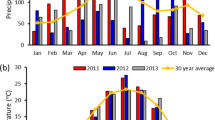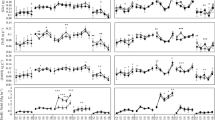Abstract
Rising energy costs, decreasing soil depth, and best management practices that require on-farm water retention have led to interest in flood-tolerant bioenergy crops for production in the Everglades Agricultural Area (EAA) of Florida. Information on the effects of high water tables on sugarcane (Saccharum spp. L.) is available; however, little is known about the bioenergy crops elephant grass (Pennisetum purpureum Schumach.), energycane (Saccharum spp. L.), and giant reed (Arundo donax L.). The objective of this study was to evaluate the role of water-table depth on the yields, morphology, physiology, and early season growth of these three bioenergy species in relation to sugarcane. The species were grown in a greenhouse and subjected to three water management strategies, −40 or −16 cm constant water-table depths, and bi-weekly flooding with drainage to −40 cm. The experiment was conducted in plant-cane, first-ratoon, and successive plant-cane crop cycles. Periodic flooding relative to a −40 cm constant water table significantly reduced dry weights and leaf area index and increased aerenchyma development. Averaged among crops, dry weight declined by 32, 49, 37, and 52% while leaf area index (LAI) decreased by 31, 50, 46, and 57% for giant reed, elephant grass, energycane, and sugarcane, respectively, in response to flooding. Aerenchyma proportional area of the stalk increased by 52, 90, and 95% for elephant grass, energycane, and sugarcane, respectively, but aerenchyma in giant reed decreased by 11%. High yields and stalk populations for all water tables were observed in energycane and elephant grass. These two species show potential for bioenergy production in the EAA. Field trials are recommended to confirm production scale yield.


Similar content being viewed by others
Abbreviations
- 16C:
-
16 cm water table
- 40C:
-
40 cm water table
- 40F:
-
Water table cycle consisting of 2 weeks of flooding followed by 2 weeks of drainage to −40 cm
- DAP:
-
Days after planting
- EAA:
-
Everglades Agricultural Area
- LAI:
-
Leaf area index
- POPCSA:
-
Proportion of pipe cross-sectional area to stalk cross-sectional area
References
Sanchez E, Scordia D, Lino G, Arias C, Cosentino SL, Nogues S (2015) Salinity and water stress effects on biomass production in different Arundo donax clones. Bioenergy Res 8:1461–1479
Erickson JE, Soikaew A, Sollenberger LE, Bennett JM (2012) Water use and water-use efficiency of three perennial bioenergy grass crops in Florida. Agriculture 2:325–338
Knoll JE, Anderson WF, Strickland TC, Hubbard RK, Malik R (2012) Low-input production of biomass from perennial grasses in the coastal plain of Georgia, USA. Bioenerg Res 5:206–214
Peng L, Jackson PA, Li QW, Deng HH (2014) Potential for bioenergy production from sugarcane in China. Bioenergy Res 7:1045–1059
Glaz B, Morris DR (2010) Sugarcane responses to water-table depth and periodic flood. Agron J 102:372–380
Gilbert RA, Rainbolt CR, Morris DR, Bennett AC (2007) Morphological responses of sugarcane to long-term flooding. Agron J 99:1622–1628
Glaz B, Morris DR, Daroub SH (2004) Sugarcane photosynthesis, transpiration, and stomatal conductance due to flooding and water table. Crop Sci 44:1633–1641
Glaz B, Gilbert RA (2006) Sugarcane response to water table, periodic flood, and foliar nitrogen on organic soil. Agron J 98:616–621
Gilbert RA, Rainbolt CR, Morris DR, McCray JM (2008) Sugarcane growth and yield responses to a 3-month summer flood. Agric Water Manag 95:283–291
Morris DR, Tai PYP (2004) Water table effects on sugarcane root and shoot development. J Am Soc Sugarcane Technol 24:41–59
Alexander AG (1985) The energy cane alternative. New York, New York
Viator RP, White PM Jr, Hale AJ, Waguespack HL (2012) Screening for tolerance to periodic flooding for cane grown for sucrose and bioenergy. Biomass Bioenergy 44:56–63
Goncalves Mota VJ, dos Reis ST, de Sales JEC, Rocha Junior VR, de Oliveira FG, Walker SF, Martins CE, Coser AC (2010) Irrigation depth and nitrogen doses on elephant-grass pastures during the dry season in the north of Minas Gerais state. Rev. Bras. Zootecn. 39:1191–1199
Rezk MR, Edany TY (1979) Comparative responses of two reed species to water table levels. Egypt J Bot 22:157–172
Andreis HJ (1976) Water table study on an Everglades peat soil-effects on sugarcane and on soil subsidence. Sugar J. 39:8–12
Bays JS, Knight RL, Wenkert L, Clarke R, Gong S (2001) Progress in the research and demonstration of Everglades periphyton-based stormwater treatment areas. Water Sci Technol 44:123–130
Glaz B, Edme SJ, Miller JD, Milligan SB, Holder DG (2002) Sugarcane cultivar response to high summer water tables in the Everglades. Agron J 94:624–629
Wright AL, Snyder GH (2009) Soil subsidence in the Everglades Agricultural Area. Univ. of Florida. EDIS SL311 1–3
Ali A, Abtew W, Van Horn S, Khanal N (2000) Temporal and spatial characterization of rainfall over central and south Florida. J Am Water Resour As 36:833–848
Daroub SH, Lang TA, Horn SV (2010) Best management practices in south Florida: a success story. Proceedings of the 19th World Congress of Soil Science: Soil Solutions for a Changing World, Brisbane, Australia. 302–305
Glaz B (1995) Research seeking agricultural and ecological benefits in the Everglades. J Soil and Water Conservation 50:609–612
Aillery M, Shoemaker R, Caswell M (2001) Agriculture and ecosystem restoration in South Florida: assessing trade-offs from water-retention development in the Everglades agricultural area. Am J Agric Econ 83:183–195
Glaz B, Miller JD, Deren CW, Tai PYP, Shine JM, Comstock JC (2000) Registration of ‘CP 89-2143’ sugarcane. Crop Sci 40:577–577
Bischoff KP, Gravois KA, Reagan TE, Hoy JW, Kimbeng CA, LaBorde CM, Hawkins GL (2008) Registration of ‘L 79-1002’ sugarcane. J Plant Reg 2:211–217
Burton GW (1989) Registration of Merkeron napiergrass. Crop Sci 29:1327–1327
Rice RW, Gilbert RA, McCray JM (2010) Nutritional requirements for Florida sugarcane. Florida Cooperative Extension Service Pub. SS-AGR-129. http://edis.ifas.ufl.edu/sc028 2012
Rice RW, Baucum LE, Glaz B (2013) Sugarcane variety census: Florida 2012. Sugar J 76:10–19
Saxton AM (1998) A macro for converting mean separation output to letter groupings in PROC MIXED. Proc. 23rd SAS Users Group Intl., SAS Institute, Cary, NC, pp 1243–1246
Glaz B, Reed ST, Albano JP (2008) Sugarcane response to nitrogen fertilization on a histosol with shallow water table and periodic flooding. J Agron Crop Sci 194:369–379
Vincente-Chandler J, Silva S, Figarella J (1959) The effect of nitrogen fertilization and frequency of cutting on yield and composition on the yield and composition of three tropical grasses. Agron J 51:202–206
Woodard KR, Prine GM (1993) Dry-matter accumulation of elephantgrass, energycane, and elephantmillet in a subtropical climate. Crop Sci 33:818–824
Mislevy P, Martin FG, Adjei MB, Miller JD (1995) Agronomic characteristics of US 72-1153 energycane for biomass. Biomass Bioenergy 9:449–457
Milligan SB, Gravois KA, Martin FA (1996) Inheritance of sugarcane ratooning ability and the relationship of younger crop traits to older crop traits. Crop Sci 36:45–50
Angelini L, Ceccarini L, Bonari E (2005) Biomass yield and energy balance of giant reed (Arundo donax L.) cropped in central Italy as related to different management practices. Eur J Agron 22:375–389
Dragoni F, o Di Nasso NN, Tozzini C, Bonari E, Ragaglini G (2015) Aboveground yield and biomass quality of giant reed (Arundo donax L.) as affected by harvest time and frequency. Bioenergy Res 8:1321–1331
Song K, Lee S, Mitsch WJ, Kang H (2010) Different responses of denitrification rates and denitrifying bacterial communities to hydrologic pulsing in created wetlands. Soil Biol Biochem 42:1721–1727
Madeira AC, Ferreira A, de Varennes A, Vieira MI (2003) SPAD meter versus tristimulus colorimeter to estimate chlorophyll content and leaf color in sweet pepper. 2009. Commun. Soil Sci. Plan 34:2461–2470
Brown RH (1978) A difference in N use efficiency in C3 and C4 plants and its implications in adaptation and evolution. Crop Sci 18:93–98
Vogan PJ, Sage RF (2011) Water-use efficiency and nitrogen-use efficiency of C3-C4 intermediate species of Flaveria juss. (Asteraceae). Plant Cell Environ 34:1415–1430
Iwanaga F, Yamamoto F (2007) Growth, morphology and photosynthetic activity in flooded Alnus japonica seedlings. J For Res 12:243–246
Nagasuga K, Kubota F, Hirao K, Nada K (1998) A consideration of the water transport status in napier grass (Pennisetum purpureum Schumach.) based on the temporary rises in leaf photosynthesis and transpiration by plants excision. Jpn J Crop Sci 67:555–560
Brito CJF, Rodella RA, Deschamps FC, Alquini Y (1997) Structure of the leaf blade and sheath of elephant grass (Pennisetum purpureum Schum. poaceae) cultivars. Arq Biol Tecnol 40:661–671
Brito CJF, Rodella RA, Deschamps FC, Alquini Y (1999) Quantitative anatomy and in vitro tissue degradation in elephant grass (Pennisetum purpureum schumach.) cultivars. Rev Bras Zootecn 28:223–229
McWhorter CG (1972) Flooding for Johnson-grass control. Weed Sci 20:238–241
Hunt F (1951) Effects of flooded soil on growth of pine seedlings. Plant Physiol 26:363–368
Author information
Authors and Affiliations
Corresponding author
Rights and permissions
About this article
Cite this article
Jennewein, S.P., Gilbert, R.A., Rowland, D.L. et al. Four Biofuel Species’ Responses to Periodic Flooding and High Water Tables on a Florida Histosol. Bioenerg. Res. 10, 688–699 (2017). https://doi.org/10.1007/s12155-017-9831-x
Published:
Issue Date:
DOI: https://doi.org/10.1007/s12155-017-9831-x




